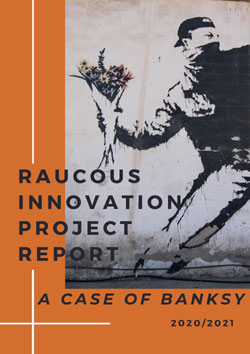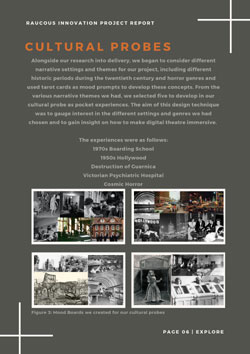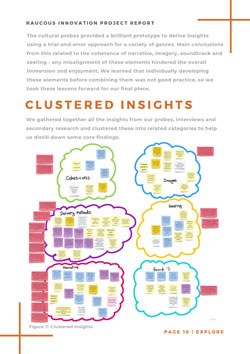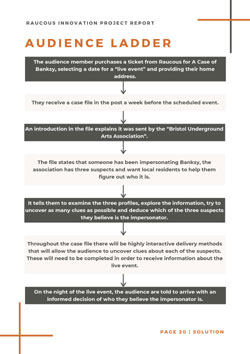
Project
Raucous are theatre makers driven by what happens when immersive storytelling & creative technology collide.
In spring 2021, they set us the following challenge:
“To develop a theatrical, immersive storytelling experience delivered through a range of digital media platforms.”
Our first step was to investigate a variety of companies designing immersive experiences, including online theatre productions, YouTube video series, AR entertainment, live-action interactive films, games, and escape rooms. We decided to get first-hand experience of these, and utilised a variety of different analysis techniques, including journey mapping, to document them.
Cultural probes are a design research method used to gather inspirational data about people’s experiences. We decided to use this technique to gauge interest in the different settings and genres we were developing and to gain insight on how to make digital theatre immersive.

The pocket experiences consisted of a short narrative description, a mood board combined with a soundtrack (in a YouTube video) and suggestions of where or how to sit when reflecting on the experience (see Bibliography). They provided a brilliant prototype to derive insights using a trial-and-error approach for a variety of genres.
All our core findings were written as problem statements, which identified the audience’s needs and expectations for an interactive experience. Key themes of self-determination, natural delivery and coherence emerged in these statements, such as:
- Personal: We needed to design the narrative around the audience, giving them an active role and choice in the story, because this makes for a more personal immersive experience.
- Delivery: We needed to derive our delivery methods from our narrative rather than using them for their own sake (e.g. extra games or puzzles) because this makes for a more natural and coherent experience.
- Coherent: We needed to design the narrative, soundtrack, and visuals coherently to make the experience immersive and create the strongest emotional response.
After further prototyping using How Might Wes and audience profiling, we developed concepts to pitch to the client. These were iterated into another final concept.

Introducing "A Case of Bansky", an immersive theatrical experience that invites the audience to uncover a Banksy imposter using a case file of information about possible suspects.
The case file is split into three sections, one for each suspect. Inside each section, there are different contents of both physical and digital elements. Whilst all potential evidence will be alluded to in our suspect cover pages, the participants may have to discover some of it for themselves, such as by using physical evidence as a springboard into digital evidence.
This is followed by a live event which reveals the culprit after a vote. As they leave the event, the audience have the opportunity to reflect on themes of anonymity and plagiarism.
Alongside the pitch, we developed various example materials that would be included in the case file.
Our solution was effectively tailored to the brief as it developed due to transforming restrictions. It creatively engages with the city, mixes physical and digital delivery methods, and provides both self-directed and live theatre. This broad approach would be appealing to the intended target markets, and we believed it would be a successful experience for Raucous to produce. It was certainly well received.
Read the full report here.
Reflective Essay

Afterwards, I wrote a reflective account of the project applying critical lenses and concepts to the evaluation of my practice in the challenge. In particular, I examined immersive theatrical experiences through two critical lenses: post-structuralism, and speculative design, in order to illustrate that immersive theatrical experiences inherently fuse these two theories to create an engaging and reflective entertainment product.
My research applied concepts of Foucault's heterotopias, Stuart Candy’s Cones for Potential Futures, and bricolage to case studies including Dungeons and Dragons, Presentable Liberty, Simulacra and Sputniko!’s Menstruation Machine. This was my conclusion:
“Immersive theatre has been presented as post-structuralist, because it gives the user agency to determine their narrative direction and takes away power from the theatre-maker by presenting opportunities for interaction and choice. It has also been presented as speculative, because it straddles the heterotopic line between naturalism and futurism by proposing alternative ways of looking at the world which challenge reality. My understanding of immersive theatre from these lenses has impacted my perspective in making sure I work with my team to create an immersive theatrical experience which has a participant-driven narrative space, creates moral dilemmas, and uses different delivery mediums coherently. This makes our project not only entertaining but successfully reflective in its interrogation of power and speculative in its exploration of alternatives.”
Read the full essay here.